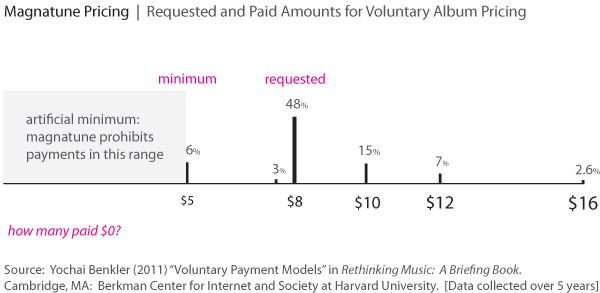
Voluntary Pricing
I put this simple bar graph together to illustrate the following text that I got from Yochai Benkler’s paper and he got from a paper about Magnatune pricing,
In the recent paper on Magnatune, the data revealed that over a five year period, 48% of users paid $8 per album where $5 was the minimum, and only 16% paid the minimum. Another 15% paid $10, 7.3% $12, etc., up to 2.6% who paid $18 per album. Payments were highly anchored around coordination focal points — for example, the drop down menu called “$8” the “typical” donation. While 48.05% of fans paid $8, only 2.93% paid $7.50 and 0.34% paid 8.50.
I wanted to see how these numbers looked as a graphic because it was a little hard to make sense of what was happening just reading about them. What concerned me was that Benkler seemed to have crafted his text to imply – but not state directly – that voluntary music pricing schemes lead people to pay more, not less, for their music. This would make a fantastic story, but for some reason I wasn’t entirely comfortable just going ahead with that implication tucked into my subconscious mind.
When I graphed it, I added a block on the lower end of the scale to help illustrate the fact that Magnatune will not sell albums below $5. So, if we were expecting a bell curve of payment choices, all of the people who might have paid less than $5 were bunched up at the $5 mark or priced out altogether. Maybe they grumbled and agreed to pay $5 when they would have chosen $2 or $3 or perhaps they just didn’t buy the album at all. It’s hard to say.
Of course, I wouldn’t really expect people to distribute their payments for an album along a bell curve. I would have expected more clustering around the lower numbers – why would people pay more if they could pay less? Especially because they may not have taken the time to listen to the whole album for one reason or another…so they are paying for something that is not completely known. We’ve all been there before – some songs on albums just aren’t as good as others.
On the other end of the spectrum are the people who not only have taken time to get so familiar with the music that they aren’t worried about the dreadfulness of the unknown. Benkler’s paper indicates that people who develop close relationships with the musicians through collaborative efforts or fansites might be willing to pay more as a sign of respect and admiration.
Getting back to the graphic as a mechanism for making sense of the information, the point is that there are actually FEWER people in the lower range than in the higher range. Nearly half of people paid the requested amount ($8) but where they deviated from the requested amount, more people paid decided to give more, rather than less.
How can we explain that irrational behavior? I’m guessing that it has something to do with the free riders, the people who aren’t paying anything at all. These are not people who are getting their music from Magnatune, these are the friends of those paying people who are sharing iTunes accounts and getting their new music for free. There are other ways to get music for free besides sharing iTunes accounts but I’m not trying to get into all that. My point is that, after having graphed this information, I feel reasonably assured that there are quite a few people who are listening without paying a thing. It doesn’t really matter to me how they are doing that.
What matters is that the shape of the graph and the distribution of payments that we can see leads me to believe that there ought to be a substantial proportion of people – at least 14% – who are free riders. That’s a very rough estimate, but it complicates the happy story that if musicians pursued voluntary pricing they might stand to make more. It’s hard to say if that’s true or not. I guess it’s nice to allow your biggest fans to ‘vote with their dollars’ and just shrug off the free-rider problem as being outside the pricing structure. If people don’t want to pay, they are going to find ways not to pay no matter how the pricing structure is set up. But if people DO want to pay more, they can only do so under a voluntary pricing scheme. If the prices are set, they cannot opt to ‘vote’ with their dollars and pay more.
*I stick ‘vote’ in scare quotes when I am linking it up to economic activity because I like to reserve the term voting for direct political participation rather than for political participation that is supposedly possible by participating in capitalist exchanges. I hardly think that consumer behavior is as critically important as electoral behavior. Not everyone agrees with me, but that’s not a topic for this post.
References
Benkler, Yochai. (2011) “Voluntary Payment Models” in Rethinking Music. Cambridge, MA: Berkman Center for the Internet and Society at Harvard University.
